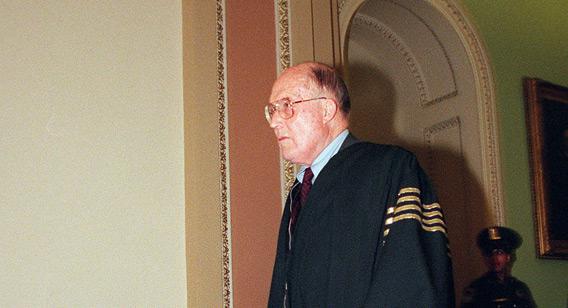William Hubbs Rehnquist was an enigma wrapped in a riddle, according to John A. Jenkins’ new biography, The Partisan. An enigma wrapped in a riddle, wrapped in an orange tie, wrapped in a drug-induced stupor, then wrapped yet again in a hard racist shell. And, as Jenkins tells it, beneath all that packaging there lay a pulsing heart of pure, ends-driven evil.
Jenkins—a well-respected journalist who scored a major interview of Rehnquist in 1984—tells the story of the former chief justice’s rise from a conservative, middle-class Milwaukee upbringing, to the highest grades in his class at Stanford Law School, to playing a leading role in Richard Nixon’s Office of Legal Counsel, then leapfrogging over far more famous candidates into a slot at the U.S. Supreme Court. Jenkins paints a picture of a clearly brilliant yet ever-striving student, law student, clerk, and attorney, arguing that most of Rehnquist’s political and legal philosophy—described as “legal nihilism”—never changed an iota after college.
But Jenkins’ story is shot through with a palpable sense of frustration and betrayal on the part of the biographer. He is plainly furious that Rehnquist got away with authoring a memorandum as a law clerk in 1952 arguing in favor of school segregation and defending the court’s shameful holding in Plessy vs. Ferguson. That memo, in Jenkins’ view, made Rehnquist an “ardent segregationist,” a sin made far more grievous because Rehnquist later blamed the memo on the justice for whom he’d clerked, suggesting it was written in Robert Jackson’s voice. Jenkins is livid at Rehnquist for going through a well-documented period of prescription drug addiction (so bad that it landed him in the hospital, delusionally racing for the exit in his jammies) and yet never being called out for his addiction during his confirmation hearings for chief justice or by a fawning Supreme Court press corps. Jenkins is angry that the same Rehnquist who intimidated minority voters on voting day never admitted to it or apologized for it. He is appalled that the same Rehnquist who defended the Nixon administration’s arrest of 12,000 Vietnam War protestors in May of 1971 sat on an appeal in that same case as a justice of the court. The Partisan is a lament, after Rehnquist’s death, that he was the most conservative, ideological, racist, and ends-driven justice in decades and yet somehow got away with all of it.
The Rehnquist who emerges is an inexplicable mystery. Jenkins time and again describes a “duality” in Rehnquist’s character: a cold and determined conservative with no patience for the legal claims of women, minorities, or death-row inmates, camouflaged behind a gregarious, almost madcap persona that was all impish charm and practical jokes. Early on, according to Jenkins, Rehnquist chose to “disguise his condescension” behind a “role” he adopted—that of the “charming rogue.” The real Rehnquist used this façade to “ingratiate himself with his colleagues.” When he worked as Nixon’s lawyer, he dressed in ugly Hush Puppies, flower-power ties, and Buddy Holly glasses. (Nixon kept wondering why Rehnquist was “dressed like a clown.”) Jenkins never quite hides his suspicion that all of Rehnquist’s bonhomie and good humor hid an iron-willed project to shift the court rightward, without regard for the law, the Constitution, or the nation. Don’t be fooled by the striped pink shirts and the Gilbert & Sullivan robes, we’re urged. The real William H. Rehnquist wanted only to be a hanging judge.
Jenkins concedes that Chief Justice Rehnquist was brilliant yet gives us a picture of a man who was desperately bored at the court: dabbling in painting, devoting years to what sound to be a pair of desperately awful novels, and forever hounding others to be as ruthlessly efficient as he always was. The Rehnquist here never wrote a memorable majority opinion and remained unbothered by that fact. He was the Lone Dissenter, the relentless voice of his parents’ all-white, middle-class Milwaukee, and as the court eventually came to coalesce around that vision; the dissent became the status quo.

Courtesy of John A. Jenkins.
Rehnquist is tagged as the man who caused the current polarization of the court, whose conservatism was as expedient as it was unyielding. For those of us who have long pondered what it was that led Rehnquist to break with his own conservatism in cases such as the 2003 appeal over the Family and Medical Leave Act or his odd 2000 flip-flop after a lifetime of trying to eviscerate the Miranda decision, Jenkins doesn’t offer much by way of explanation. Those cases are outliers, he suggests. The real Rehnquist was made manifest when Bush v. Gore was handed down in 2000: a poke in the eye to states’ rights, an unprincipled departure from stare decisis, and a “limited-to-the-present-circumstances” party trick that showed how little regard Rehnquist had for the job of serious jurisprudence. This is a Rehnquist who cared only about winning and also a Rehnquist who won.
Those who agree with Jenkins’ argument will enjoy this meticulously researched account, right down to the recounting of the petty public arguments between Rehnquist and John Paul Stevens over Chicago Cubs trivia and the way he eventually forced Sandra Day O’Connor’s premature retirement. Those who disagree will find the picture of a small man with very great influence to be deeply unfair. Either way, the account fails to answer some of the very same psychological questions it raises: Who was the real Rehnquist—the icy cold racist or the jolly singer of Christmas carols? Did one role serve to soften the other, or did the bossy, unforgiving Rehnquist long to be something other than a lone warrior for Nixon at the high court?
We may never know why William H. Rehnquist—a man who suddenly changed his own middle name, signed his letters to loved ones “Felix” (as in Frankfurter), and never quite knew what his clerks should call him—struggled as hard as he did to create a public identity that sat so very awkwardly around his private shoulders. Something never quite fit, and that’s all we may ever fully know. But the Rehnquist we meet in The Partisan seems less sure of himself than his biographer is. And whatever one’s legal and political ideology, that seems something of an injustice in the end.
—
The Partisan: The Life of William Rehnquist by John A. Jenkins. PublicAffairs.
See all the pieces in this month’s Slate Book Review.
Sign up for the Slate Book Review monthly newsletter.
